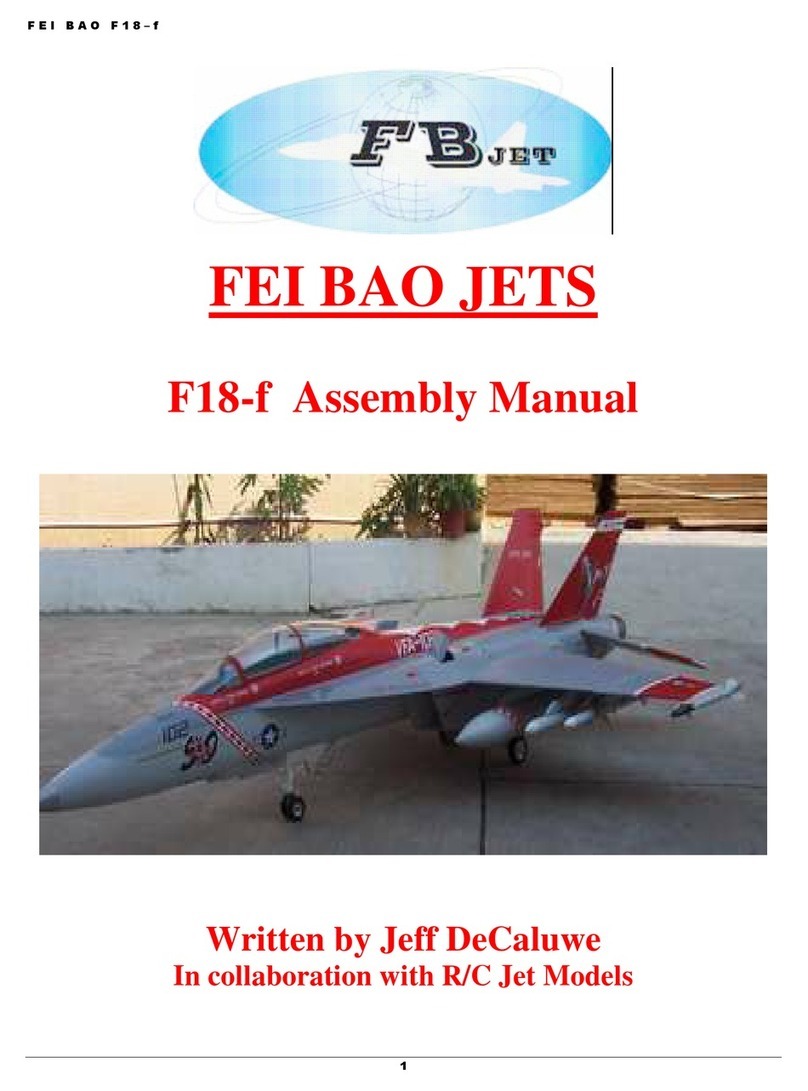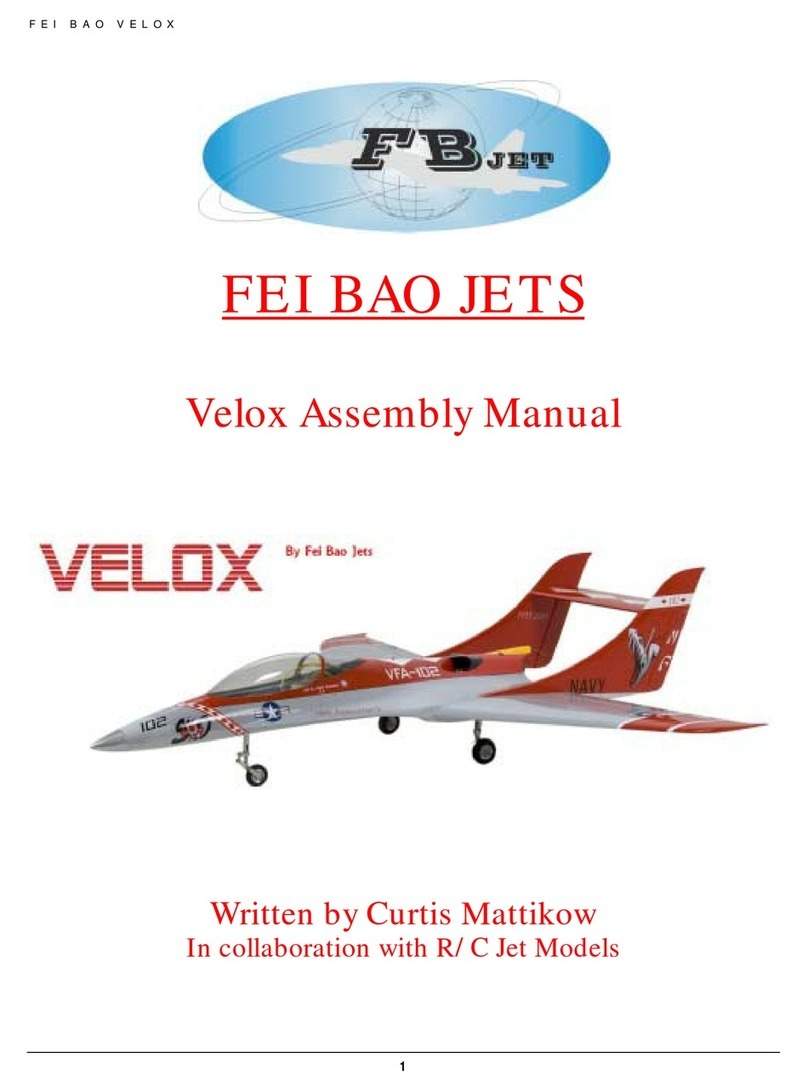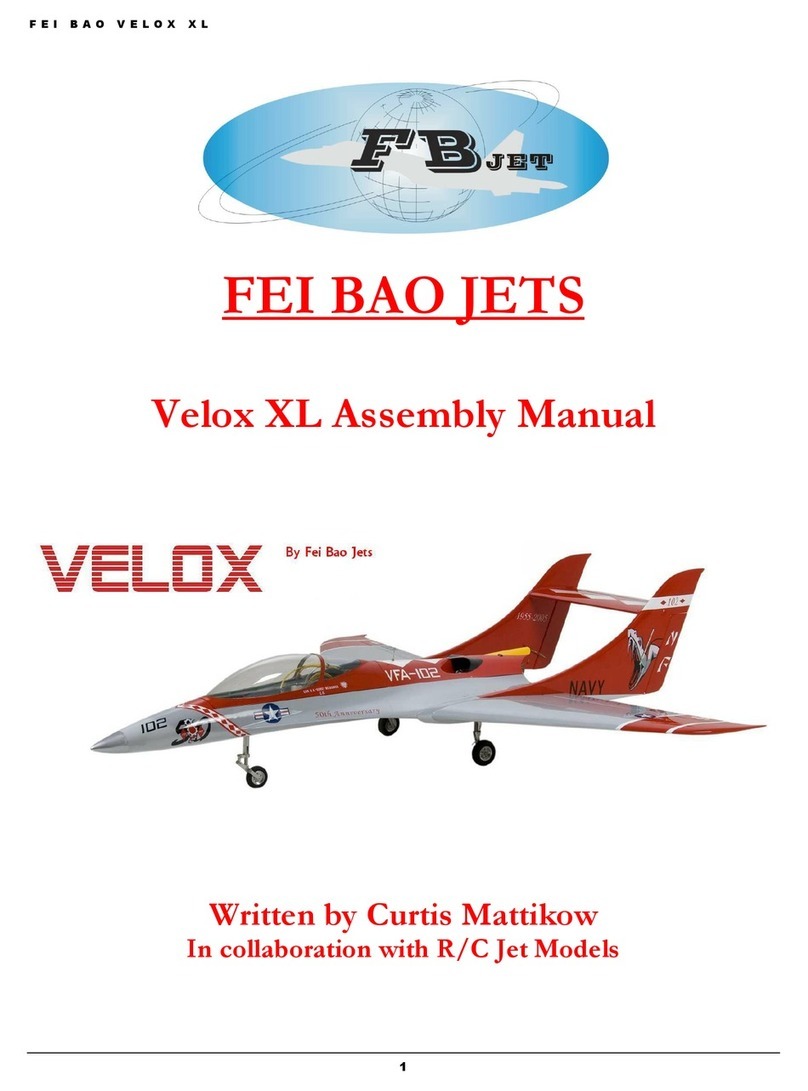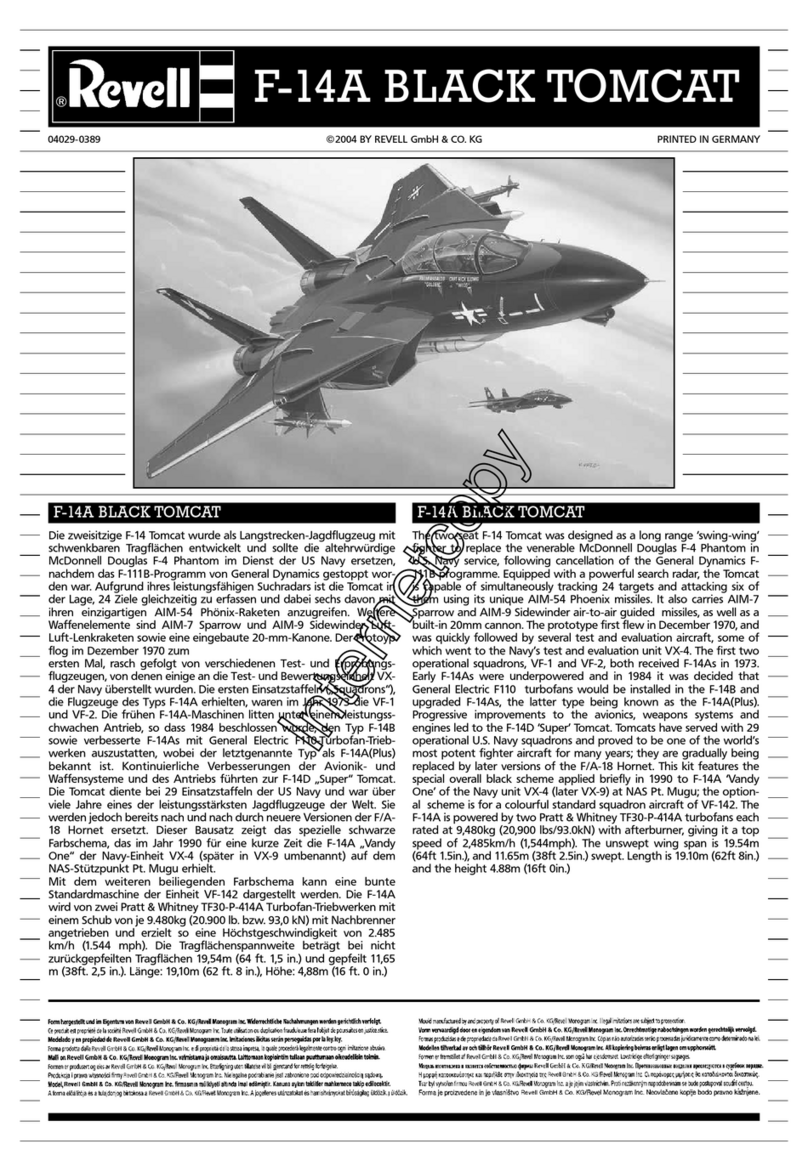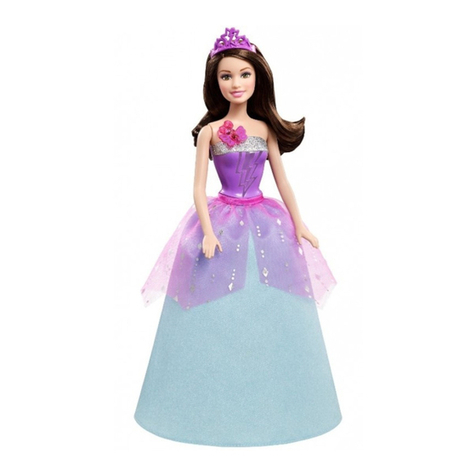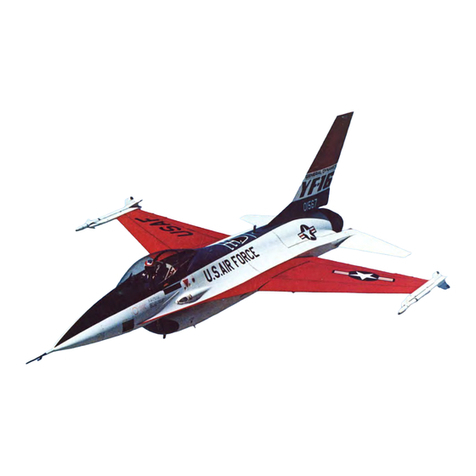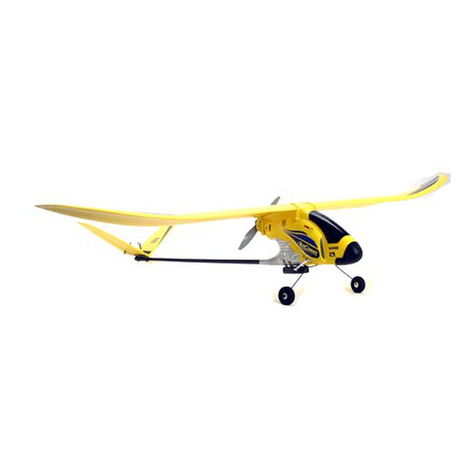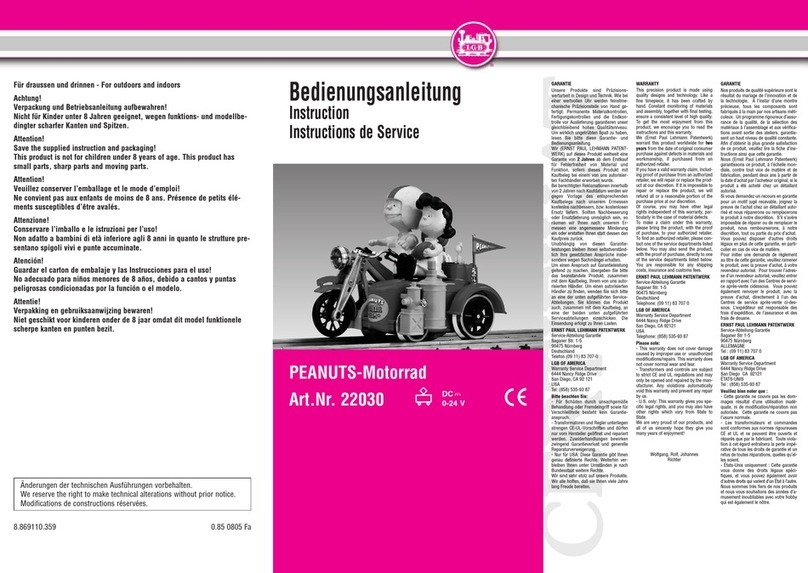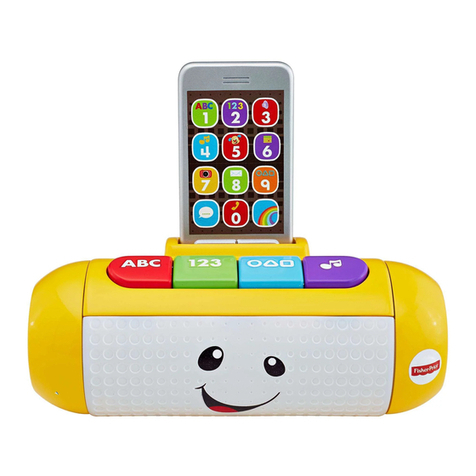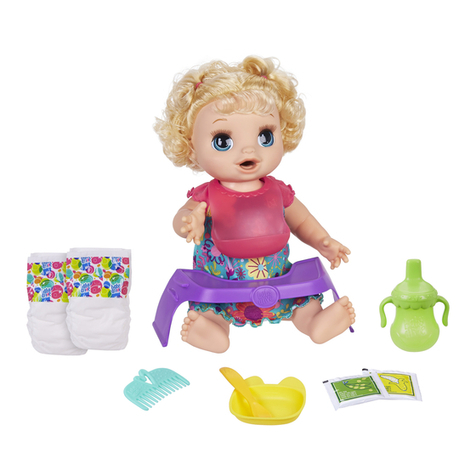Fei Bao MB-339 User manual

1
Fei Bao MB–339 Instructions
DISCLAIMER
THIS IS NOT A TOY. This is a high-performance miniature aircraft,
capable of high speeds and damage to life, limb, and property. The
manufacturer and its distributors cannot control ho you assemble
this model, hat equipment you use to fit it out, or ho you fly it,
and can assume no liability hatsoever for any damages that may
occur hen you fly your aircraft. By assembling this model, you are
agreeing to indemnify and hold blameless the manufacturer and/or
his agents from any and all torts and liability associated ith the use
of this product. Please inspect all parts before beginning assembly.
If any parts appear to be suspect, contact your dealer or the
manufacturer for repair or replacement BEFORE you begin. Once
you have assembled the aircraft, you are the pilot in command and
assume any and all responsibility for the use of the model and any
damages that might occur by flying or attempting to fly this aircraft.
R/C model jets require a high level of skill in both their assembly and
their flying. If you do not feel confident in either your building or
flying skills, PLEASE seek assistance from more experienced
modelers. It is a ise idea, no matter hat level of skills you
possess, to have a second experienced modeler go over your
installation after assembly. A second set of eyes may spot a problem
you have missed. If you have not flo n a model like this before, it is
HIGHLY recommended that you get an experienced turbine pilot to
do your maiden flight. Very often, the first fe seconds of a maiden
flight are critical until the aircraft is trimmed out, and having an
experienced pilot at the controls can make the difference bet een a
recked aircraft and once that enjoys many hundreds of flights. Be
sure to select a suitable field for flying...take the time to find a large
paved run ay if at all possible, especially for test flights, until you
feel comfortable getting the aircraft in and out of smaller grass
fields.
Before you begin
Keep this in mind as you proceed:
Look at EVERY assembly step you finish, and ask yourself:
"Is this going to cr sh my irpl ne?"
A chain is only as strong as its eakest link, and this is a high-
performance aircraft that ill be very intolerant of sloppy assembly
techniques. Even the smallest component is important and can
cause the loss of your airplane, so take the time to do things right.
Or REdo them if they are rong. Careful ork ill result in a long-
lasting plane that gives you years of pleasure, one loose component
could result in the complete loss of the aircraft and all the
components inside it, and someone can even get hurt. So pause
every once in a hile hen building it and double-check your
orkmanship.
Introduction
You have chosen a model that represents the pinnacle of ARF
technology. While there is not a lot of building to do, there is
enough to keep you busy for a fe evenings.
Even if you have assembled maybe other ARF jets, e highly
recommend follo ing our assembly sequence and procedures
any ay. Chances are it ill save you a lot of time, prevent you from
running do n dead ends, and perhaps remind you of a fe small
things that might end up saving your aircraft.
We have tried to arrange a construction sequence that ill allo you
to keep moving for ard, rather than standing around aiting for
glue to dry before you can proceed to the next step.
Just because the model is almost completely built does not mean
you can rush through the final assembly.
You need to employ fine craftsmanship every step of the ay,

2
turbine models are critical. Keep this in mind ith everything you
do, every part you install...look at the ork you just did, evaluate it
critically, and ask yourself "is this going to potentially crash my
airplane?" If there is any doubt about the ork you have done, back
up, and re-do it properly.
Adhesives
The correct adhesive to use for all procedures is Loctite Hysol 9462.
This is a very strong hite epoxy that is thixotropic. "Thixotropic"
means it does not run at all, but stays only here you put it. It is
infinitely superior to regular epoxy, even slo -setting epoxy, for our
purposes, because of this characteristic. Regular epoxy ill run
do nhill ith gravity as it dries, taking it a ay from here it is
supposed to be. A good example is in the hinges...using regular
epoxy, a good portion of the glue ill migrate do n a ay from the
hinge into the inside of the ing as it dries, and you on't even
kno it is happening. Hysol stays here you put it. The do nside
of Hysol is it takes overnight to dry properly, but e have tried to
arrange things to keep you busy hile aiting for glue to dry.
We also highly recommend that you only use a proper Hysol
dispensing gun, and only the long-type mixing nozzles.
The short nozzles do not mix this glue enough, and only a thin
nozzle and gun ill let you fill the hinge and control horn holes
properly ith glue, you can't do it mixing your Hysol on a flat surface
and trying to get the glue in the proper place by a brush or stick.
You can buy a complete Hysol setup ith a gun, nozzles, and t o
cartridges of glue from your dealer for approximately $60.
Consider it a great investment, the glue is the best you ill use.
One cartridge is plenty to assemble your MB339.
Working with pneum tic systems
The MB339 uses pneumatic brakes and retracts. If you follo a fe
tips, you should have very reliable, leak-free operation. Neatness
counts. All airlines should be secured to the airframe to keep them
from flopping around or getting kinked. Use tie raps for this.
The other very important thing is to cut off the end of each airline
dead square before installing it on the nipple. This is VITAL. You
can either purchase a professional tubing cutter from your dealer
(they are approximately $10), or you can make up a little jig to hold
the airline and keep a sharp, ne razor blade perfectly upright as
you cut. Either one orks, just ensure that all ends of all airlines are
cut off dead square. Make sure all airlines are pushed ALL THE WAY
onto their nipples. They should not need to be secured other ise,
but you can add fine ire safety raps if you like. Make sure all left
and right matching airlines are the same length, particularly the
brake lines, or you ill get uneven retraction or braking action.
It's orth taking the time to get everything pneumatic right the first
time, as having your landing gear fail to retract is not THAT bad, but
having it fail to deploy can really ruin you day and the paint on the
bottom of your model.

3
Construction
Prelimin ry steps
• Clean and inspect all parts. Inventory them against the parts list
at the end of the manual and notify the kit supplier of any
missing components as soon as possible.
• If the paint scheme you have selected is glossy, it is
recommended that you apply a coat of ax. This ill help resist
dirt, stains and fingerprints during construction, and ill provide
some limited protection against errant glue.
• Vacuum out the remnants of packing materials that remain in
the fuselage.
While the kit is comprehensive, there are additional parts required,
as follo s:
• Recommended Servo List (JR)
• Elevators: (2) 8611a
• Aileron: (2) 8611a
• Flaps: (2) 8611a
• Rudder: (1) 8411
• Nose Steering: (1) 8611a
• Retracts: depends on retract and door solution selected
• Speed Brake: (1) 351 or equivalent
• Brakes: (1) 351 or equivalent, or an electronic brake unit
• Other Parts
• BVM UAT (optional)
• Fuel tank vent fitting
• Festo fuel shutoff valve
• Wire t ist tie (optional)
• Blue Loctite
• Glues: Thin CA, 5 minute epoxy, 30 minute epoxy,
Aeropoxy, Zap-a-Dap-a-Goo
• Electronic gear sequencer, or UP2/UP4 combination
• Brake valve
• Batteries, regulator and s itch
• Matchboxes, Po erbox, Smartfly EQ10 or equivalent
• Servo extensions (length may vary, depending on receiver
placement)
Gener l Construction Notes
The order of construction may be changed to suit your personal
preference, ho ever, the model is more easily orked in a tight
space if ork is completed on each fuselage section before they are
joined. The tail surfaces must be attached before the aft fuse is
joined to the for ard fuse, as the pipe must be in place during this
step and it blocks access for iring.
The retract system doors operate in t o different ays. The main
gear doors and the large nose gear door open, the landing gear
cycle either up or do n, and the doors close again. For this action,
you ill need t o separate valves ith a sequencer or an Ultra
Precision UP-2 valve. The small doors that bracket the nose heel
strut must remain open hen the gear is extended. There are t o
ays this may be accomplished. The simple approach is to connect
the cylinder open line to the gear do n line, and the door close line
to a pressure s itch that is connected to the gear up line and
activated by the nose gear steering servo hen in the retracted
position. This is the method that is sho n in these instructions. If
you use a UP-2 valve for the larger doors, you can add a UP4 valve
to the system for the smaller nose gear doors.
You ill likely need to match t in rudder and t in elevator servos.
This may be accomplished ith servo reversing “Y” harnesses, JR
Matchboxes, the Smartfly EQ10, a Champion Po erbox or equivalent
gear.

4
Step 1: Check Forw rd Fusel ge
Remove the fuel tanks from the fuselage.
Also remove the t o for ard component boards. No ould be
a good time to put a coat of paint on these parts if you ould
like to protect the ood surfaces.
Vacuum and thoroughly clean the fuselage.
If the nose gear as installed at the factory ith bolts and lock
ashers, check these for security no .
Put a very small dab of thin CA on the three nuts that secure the
nose gear door cylinders to the door actuating arms. A small
toothpick helps limit the amount of glue applied.
Repeat this step for the three nuts that attach the door cylinders
to their respective mounting blocks.
Check all door hinges for security.
Ne er kits have carbon fiber reinforcement in the nose section.
Older kits ill require that this be added. Start adjacent to the
intakes and epoxy carbon fiber strips for ard to the nose.
Run a bead of Aeropoxy do n the sides of the three nose
formers to reinforce the joint ith the fuselage side. See
photo
1.
photo 1 – optional fuse strengthening
Step 2: Prepping the Fuel System
Disassemble and inspect the tank cap hard are. As
photo 2
sho s,
the process used to cut the tubes may leave behind a rim that
constricts fuel flo and could result in excess tank pressure and
leakage. The vent tube to the top of the picture sho s hat the
constriction looks like before repair, hile the fuel tube on the lo er
left sho s hat the tubing should look like after clean up. If the
tubing is not constricted, skip for ard to the leak check.
photo 2 – correct tube constriction if necessary
Loosen the Philips head scre and remove the stopper assembly
from the tank.
Use a small, round Perma-Grit rat tail file or an Exacto knife to
remove the excess metal. You ill need to inspect the ends of
all tubes.
When finished, make sure to blo out the metal fragments and
clean up any sharp edges.
While the components are apart, check the Tygon pickup line for
equal lengths in both saddle tanks. They should be long enough
to reach the back of the tanks ithout being so long as to
restrict their ability to move to the top of the tank hen the
aircraft is inverted. Allo a small amount of play to allo the
tubes to stretch slightly over time.

5
You should also notch the vent tube ith a small file to provide
for continued air flo should the tube come into contact ith the
top of the tank.
Make sure the bends to the vent tubes applied at the factory
have not restricted airflo to any significant extent. Also, check
the Tygon for any nicks or cuts and secure to the tubing ith
ire ties before re-assembly.
Reassemble and mark the tank for vent and fuel for later
reference.
Once the tanks are back together, they should be leak checked
before installation in the aircraft. Connect extra lengths of fuel
tubing to the fuel and vent lines and submerge the tank in
ater. Pinch off one line and gently pressurize the tank by
blo ing into the other, looking for signs of air bubbles. If the
tank sho s evidence of air leakage around the vent cap, tighten
the Philips head scre and check again. If you have a stubborn
leak, you can re-tap the inner plate for a slight larger 6/32 cap
head bolt.
Step 3: T nk Inst ll tion
photo 3 – lo er foam support
Re-attach the Tygon tubing to the main saddle tanks. Make sure
the lines are of equal length. Exercise care not to break the
tanks hile fitting the Tygon. Slo ly iggle the tubing into
place. Wire tie for security.
Cut a scrap piece of fairly stiff foam 3” x 5” x ½” and secure to
the bottom of the fuse at the rear of the saddle tank bay ith a
fe drops of thin CA (
photo 3
).
Insert the saddle tanks into position, slipping the Velcro hold-
do n strap into place as you do.
Cut another piece of scrap foam 2” x 3” x ¾” and slip it bet een
the saddle tanks at the bottom of the fuse.
Cut t o pieces of scrap foam 2” x 3” x 1” and secure these to
the sides of the fuse at the rear upper corner of the tanks ith a
fe drops of CA to provide added support (
photo 4
).
photo 4 – side foam support
You ill need to make t o center tank supports from scrap ply. The
tank needs to sit far enough back from the cockpit for fuel lines to
clear the back of the main hatch area. It also needs to incline
slightly from rear to front to insure adequate clearance for the
engine hatch.
Temporarily position the lo er engine bypass on the mounting
rails.
Slip the intake extension into place and secure ith the aft
Velcro strap.

6
Position the center tank on top of the intakes, far enough aft of
the canopy area to allo clearance for the fuel lines.
Fashion a rear tank support from ¼” scrap ply and position it on
top of the intake extension. You ill need to radius this piece
slightly ith a Dremel tool to match the incline of the extension
tube.
photos 5 and 6 – rear and front center tank supports
Check the position of the tank once more ith the engine hatch
in place. When satisfied, tack glue the tank support in place
ith a fe drops of CA (
photo 5
).
Shape a front tank support from scrap ply. The ply piece ill be
glued bet een the intakes and should be notched at the top to
keep the tank from slipping for ard during flight (
photo 6
).
Secure ith a fe drops of CA.
photo 7 – Aeropoxy tanks supports in place
Remove the center tank and secure these tanks supports in
place ith a generous amount of Aeropoxy (
photo 7
).
There are various ays to secure the intake in place to keep it
from sliding to ard the rear of the plane, but the simple ay to
do it is to attach it to the for ard former ith ire ties. This
makes it immediately removable in the event the saddle tanks
must be serviced (
photo 8
).
Fashion a rear tank stop from scrap ood and attach it to the
intake at this point. Secure ith Aeropoxy. Replace the center
tank and secure the Velcro hold-do n strap. (
photo 9
).
Check the fuel lines for nicks and cuts as you proceed through the
next steps.
Connect the t o fuel pickup lines from the saddle tanks together
ith a “T” fitting.

7
Connect this “T” fitting to the vent line of the center tank.
Connect the t o vent lines together from the saddle tanks ith a
“T” fitting.
photos 8 and 9 – securing intake and rear tank stop
Attach this “T” fitting to a fuselage vent fitting. It is suggested
you place this just ahead of the right intake, slightly up from the
bottom of the fuse. This ill prevent “catching” the fitting if you
slide the fuselage on a foam transport pad. Reinforce the
fuselage ith a scrap piece of carbon fiber to add a little
strength to this area (
photo 10
).
photos 10 and 11 – vent tube reinforcement and UAT installation

Connect the fuel pickup from the center tank to the optional UAT
or to the fuel pump. In the prototype, the UAT is located just
above the right intake. (
photo 11
).
Step 4: Nose ge r
Working from inside the aircraft, scre the nose steering servo
to the bracket (
photo 12
). Do not use rubber grommets and
make sure to use Loctite on the scre s. The servo is oriented
ith the output spindle to ard the top of the plane. If your
servo has a reinforcing ridge on the mounting tab, you may
need to remove it ith a razor knife to allo the servo to sit flat.
photo 12 – installing nose gear steering servo
Lo er the gear.
Adjust the steering arm clevises until they are approximately the
same length, ith the servo arm positioned on the servo spindle.
Using a Matchmaker or similar device, center the servo and
mount the arm. Readjust the clevis if there is any evidence of
binding (
photo 13
).
When satisfied, use a small drop of thin CA on each clevis to lock
it on to the threaded rod.
Step 5: Nose Doors
It ill be helpful at this point to locate the positioning of the air
system valves. A sample installation is sho n in
photo 14.
photo 13 – nose gear steering linkages
photo 14 – sample layout of air systems on for ard component board .. leave room
for cockpit above and air tanks belo

9
In the prototype, the larger of the three air tanks serves the gear
and doors, hile the smaller tanks serve brakes and air brake
respectively.
Refer to the general construction tips for an explanation on
gearing up the air systems.
Install three air tanks in the space beneath the for ard
component board, ith the large tank in the middle. Use several
dots of a silicone based glue such as Zap-a-Gap-a-Goo. Don’t
overdo the glue, ho ever, as you may ant to remove the tanks
in the future and the component board ill hold the tanks
partially in place in any case.
When the glue is dry, run air system lines to the tanks. In the
prototype, all air and fuel fill lines are run to the rear hatch so
that the cockpit may be left in place hile servicing the plane.
Lay out the air system components on the for ard component
board and then bolt the board into place ith four small ood
scre s.
Run air lines to the nose gear and nose door cylinders. A little
patience and good skills ith a forceps ill be required. Test
each line as you go ith a hand pump for leaks. It ill also help
to follo a color coding scheme for future line identification and
trouble shooting.
photo 15 – air micro s itch to active small nose gear doors
As described in the general notes, the t in doors that flank the
nose gear strut in the prototype are activated by an air micro
s itch. Make a small platform of scrap ply and attach the micro
s itch ith a ire tie or a bracket. Push the s itch up against
the bottom of the steering servo hen it is in the retracted
position and secure to the top of the retract unit ith ire ties
(
photo 15
).
Step 6: Vertic l Fin nd Rudder
Before attaching the aft section of the fuse, the vertical fin and
horizontal stabilizers need to be attached and the ires run from the
servos. This is because the pipe must be in the aft section hen
installed, and access to the iring is restricted once the pipe is in
place.
In most kits, the hinges are preinstalled in the control surfaces, but
must be glued into the flight surface.
When removing the servo ell covers, label appropriately for proper
re-installation.
Trial fit the rudder into the vertical stab. You may need to snip
about 1/8 inch off the bottom hinge as it butts up against the
rear aluminum spar. Trim and sand to achieve the maximum
thro your servo arm ill allo .
Attach t o aluminum “L” brackets to an 8411 servo or
equivalent. Position the brackets such that the spindle of the
servo faces for ard hen installed in the servo ell. Do not use
the rubber grommets supplied ith the servo, but bolt it directly
to the brackets. Use Loctite.
Using a JR Matchmaker or your receiver, po er up the rudder
servo and set it at neutral. Attach the control arm at a vertical
position.
Position the servo on the t o ply mounting tabs and attach the
“L” bracket ith 15mm ood scre s.
Run the servo ire out of the bottom of the vertical stab.
Trial fit the phenolic control arm in the slot routed in the rudder
at the factory. You may need to use a small carbide cutter to
enlarge the slot slightly for a good fit. Be careful not to route
through the other side of the control surface. A small piece of

10
tape rapped around the cutter at the proper depth ill help
prevent a mishap.
Roughen the surface of the control arm here it ill glue into
the rudder ith 100 grit sandpaper.
Tape around the slot ith masking tape and apply a liberal
amount of Aeropoxy into the slot (
photo 16
).
photo 16 – Installation of control horns
Secure the hinges into the vertical stab and the control horn into
the rudder ith Aeropoxy. Remove the masking tape and allo
to dry overnight. Make sure to check the vertical stab for any
glue marks or fingerprints before setting it aside.
Locate t o 15mm bolts and large ashers. Trial fit these in the
vertical stab mounting posts.
Insert the vertical stab into the aft section of the fuselage and
secure ith the t o bolts.
Install a servo extension of the proper length to reach your
receiver and secure the connection ith a large piece of heat
shrink or tape.
Step 7: Horizont l St bilizers
The horizontal stabs build up in a similar fashion to the vertical
stab. Repeat all steps, including the installation of the servos,
elevator hinges and control horn.
Before installing the servos, use a Matchmaker or equivalent to
center the servos and match the positions of the control arms.
If you are using JR Heavy Duty Arms and the positions don’t
match, try rotating one arm 180 degrees before deciding hich
half of the arm to trim off.
If you are installing 8611 servos, you ill need to trim the ply
mounting tabs and metal arms to get a good fit (
photo 17
).
photo 17 – elevator servo installation
You can make the horizontal stabs easier to remove if you install
the servo extension such that the servo plugs in at the fuse
joint.
Install the t o carbon fiber spars through the aft fuse.
Find the 20mm horizontal stab mounting bolts and trial fit into
the metal threaded tabs.
Working carefully, enlarge the hole in the top of the aft fuse
such that the stab mounting bolt ill sit flush ith the top of the
fuse. Do not drill this hole straight through, but make it just
large enough for the head of the bolt. In the prototype, the

11
proper diameter as achieved ith a conical bit and then the
depth as cut ith a small carbide cutter (
photo 18
).
Slip one horizontal stab on the spars and secure ith a bolt
(
photo 19
). Loctite.
photos 18 and 19 – installation of horizontal stabilizer bolt
Push the spars fully into the stab that you just mounted, and
then slip the other stab on the spars, securing ith a bolt.
Loctite.
Run all extensions for ard through the aft fuse, making sure
they are adequately secured a ay from the pipe.
Step 8: H tch Covers nd Link ges
Cut slots for the control arms in the servo covers for the vertical
and horizontal stabs and reinstall.
You may ant to paint the control horns to match the paint
scheme at this point.
With control arms in the vertical position and the control surface
centered, adjust the linkages to the proper length for both
elevators and the rudder.
With the t o elevator servos activated through the Matchmaker,
set the length of control linkage such that the elevators are
equally centered and attach (
photo 20
). Make sure not to over-
tighten the bolts such that the arm binds.
photo 20 – elevator linkage

12
Step 9: Aft Fusel ge
Drill a hole in the pipe mounting tabs at their mid-point.
Position the pipe on the rear of the lo er bypass. The tabs are
slightly offset to one side of the pipe … this is the top.
With the pipe fully on the lo er bypass, and the mounting tabs
equally spaced from the top, drill holes through the lo er bypass
for the tab mounting bolts.
Trim the mounting tabs back a bit if necessary to insure they
don’t interfere ith the fit of the upper bypass.
Insert the pipe into the aft fuse.
Attach the aft fuse to the for ard fuse ith four bolts. Loctite.
Secure the ire harness to the side of the fuse to keep it a ay
from the pipe (
photo 21
).
photo 21 – mounting aft fuselage
Step 10: Engine nd Pipe
Clean the fuselage thoroughly before installing the engine. If you
need to trim the intake for engine clearance, use a vacuum hile
you ork. This ill reduce the chance of a foreign object finding its
ay into your engine.
Move the pipe aft and position the lo er bypass on the
mounting rails. Trim the engine rails as necessary for a good fit.
Bolt the pipe mounting tabs to the lo er bypass.
Position the aft end of the exhaust pipe even ith the lo er fuse
at the rear exhaust opening. (
photo 22
).
Trim the intake such that it extends inside the lo er bypass by
approximately ¼ inch.
Slide the pipe/bypass assembly to the rear again, and slip your
engine into the lo er bypass. Move the entire assembly for ard
into position.
photo 22 – position of aft pipe
Adjust the location of your engine to obtain the clearance
specified by the manufacturer bet een the exhaust cone and
the pipe mouth. It is likely it ill extend into the intake.

13
photo 23 – engine mounted in lo er bypass
Shim the engine as necessary to make sure it is centered in the
pipe and is aligned ith the slope of the pipe from front to rear.
When you are satisfied, bolt the engine to the side frames ith
ood scre s. Remove the scre s and coat the thread holes
ith thin CA. This ill harden the ood. Connect service lines
to the turbine and bolt permanently in place (
photo 23
).
photos 24 and 25 – rear component board. Note receiver position on upper right.
Drill and secure the bypass to the engine mounting rails ith
four ood scre s if necessary.
If the pipe is loose as it passes through the rear former, glue a
piece of ply at the top of the former to hold the pipe more firmly
in place. Access is from the rear.
Complete the installation of engine components on the rear
component board. Remember to leave clearance for the cockpit
above. The placement of components in the prototype,
including the smoke system, is sho n in
photos 24
and
25
. The
rear component board has been raised slightly for installation of
smoke tanks beneath.
Resist the temptation to hide ires a ay under the component
boards, as it ill make future maintenance more difficult. Keep
things neat but accessible.
Step 10: Wing L nding Ge r nd Doors
You ill find it easier to route air and servo lines if you enlarge
the access hole in the ing root ith a carbide cutter (
photo
26
).

14
photo 26 – enlarge air line and servo ire access hole in ing root
Extend main gear, remove the small scre that attaches the
strut cover linkage to the strut, and remove the main gear.
Put a drop of thin CA into each scre hole to strengthen the ply
in the area of the bolts.
If not already done, attach air lines to the main gear and check
for leaks ith a hand pump.
Attach brake line and check for operation of the brakes and
leaks ith a hand pump.
Optional step: The gear door cylinder may be attached to a
small extended “ear” on the door hinge. To reduce the risk that
this ear fails, you may ish to move the ball link attach point to
the hole immediately next to the “ear”, but drilled through the
main arm itself. If you undertake this optional step, you ill
also need to move the bolt location on the cylinder base
mounting plate so as to maintain appropriate thro s (
photo
27
).
photo 27 – optional repositioning of main door cylinder attach bolt
Attach air lines to the door cylinder if not already accomplished.
Test for leaks.
Put a drop of thin CA on the small nuts at both door cylinder
bolt locations to reduce the risk that they loosen over time.
Route all air lines to the ing root.
Reinstall main gear. Check for smooth operation ith a hand
pump.
Wire tie the brake line to the main strut and check operation of
the gear once more to make sure brake line has adequate
length and clearance.
Reinstall small bolt to secure door linkage. Use a small amount
of thin CA to secure bolt into strut. Also put a drop on the nut
attaching the linkage to the door itself.
See
photo 28
for picture of completed main gear and door
cylinder installation.
Wire tie and then cut off air lines at ing root. Install quick
disconnects. It is recommended you leave some extra length,
particularly on the brake line, in case lines need to be removed
and the ends clipped for maintenance or to repair a leak.
Repeat all steps for the other ing.

15
photo 28 – completed main gear and door installation
Step 11: Aileron nd Fl p Servos
Remove the aileron and flap servo covers. Mark the inside front
of the covers so you ill kno ho to orient them for re-
assembly.
Attach the aluminum L brackets to the servos as you did for the
tail surfaces. The servos ill face in opposite directions and the
servo spindle is positioned to ard the front of the ing.
Using your receiver or JR Matchmaker, find servo neutral and
attach the heavy-duty servo arms to obtain matching positions.
If you are using a double-sided arm, you may find that rotating
the arm 180 degrees achieves a better match, so complete this
step before trimming off the unused side of the arm.
Temporarily fit the ailerons and flaps to the ing if not already
completed at the factory.
Position the servos onto the mounting tabs, paying attention to
the position of arm relative to the control horn slot marked on
the control surface.
Using great care not to pierce through the top of the ing, drill
and bolt the servos in place (
photo 29)
.
photo 29 – flap servo installation
You ill need to use an extension on the aileron servo lead.
Make sure to tape the connection and secure the iring to ribs
as it passes through the gear door compartment to prevent
fouling of the extension on the heel. Label the servo ires for
aileron or flaps.
Trim the servo covers for the servo arms and reinstall.
Repeat for the other ing.
Step 12: Fl ps nd Ailerons
Measure the thro s for ailerons and flaps. Make sure you can
achieve 45 degrees of thro on the flaps and at least 20 mm in
either direction on the ailerons. Carefully trim a ay the gap
cover if needed to get the appropriate travel. Also make sure
there is no binding at the point that the flaps and ailerons come
together.
When satisfied, Aeropoxy the hinge points into the ing
permanently.
With a small carbide cutter, route out the slots for the control
horns.
Rough up the mounting surface of the control horn, tape around
the slot and glue the horn into each control surface ith
Aeropoxy.

16
Set the ings aside for the glue to cure. Double check to make
sure there are no fingerprints or excess glue on the ing
surfaces.
When the glue has cured, install the linkages.
Insert the ing tip tanks into the mounting holes. When the
pins are fully inserted, tighten the locking clamp bolts through
the small holes in the bottom of the ing.
Locate the spar tube. Note there are holes drilled and tapped at
both ends of the tube through the hard ood filler block. Insert
the tube into one ing and check to see if the hole aligns. If
not, remove the tube and invert. When you find the proper
orientation, mark the tube for left and right for future reference.
Run the spar tube through the fuse, connect service lines and
bolt ings in place.
Air up system and connect a Matchmaker or similar device to the
retract servo. Test the system, correcting any leaks or other
issues at this time.
Step 13: Wing Fences
There is one large ing fence and t o smaller ing fences on each
ing. The t o smaller fences are located to ard the outer tip and
the large fence is approximately t o thirds of the ay to the tip.
The locations for the fences are molded in the top surface of
the ing.
Mark the locations of the mounting tabs on the fences on the
ing surface
Route the tab slots in the ing, orking carefully ith a razor
knife.
Insert the fence into the slots and ick thin CA into the tab
area. Tilt the ing and let the CA ick do n the length of the
fence, being careful not to apply so much that it puddles or runs
at the end of the fence. Take your time on this step.
Repeat for the remaining fences.
Step 14: Cockpit
Trim the edges of the cockpit area so that the rear tub sits do n
fully into the for ard fuselage (
photo 30
).
photo 30 – trim the sides of the cockpit area such that the tubs drop in place
Repeat for the for ard tub. Make sure both tubs clear any
electronic gear sitting on the component boards.
At this point, you may ish to paint the tubs, rear instrument
panel and glare shield ith flat black paint.
Position the rear tub over the canopy frame and trim the back
panel to a size just slightly smaller than the rear of the canopy
(
photo 31
).
Trial fit the rear tub into the canopy. You may need to trim the
lo er cross member of the canopy slightly to move the tub fully
aft. When satisfied, attach the tub to the canopy frame ith
several dots of Zap-a-Dap-a-Goo. When orking ith this glue,
make sure not to get any “threads” of glue on the canopy itself.

17
photo 31- use the cockpit as a template to trim the back of the aft tub to shape
Attach the rear instrument panel to the tub in the same fashion
(
photo 32
).
photo 32 – glue the rear tub and instrument panel into the cockpit frame
Carefully fit the front tub into place, trimming as necessary.
Glue into place ith Zap-a-Dap-a-Goo (
photo 33
). Recheck the
fit of the canopy into the for ard fuse before the glue fully dries.
photo 33 – front tub glued in place on top of canopy rails
While the for ard glare shield may be permanently glued in
place, taping from inside ill allo for easier access to batteries
and nose gear for maintenance. Duct tape orks ell for this
application.
Step 15: R dio Progr mming
Complete the installation of your radio gear and batteries. In
the prototype, the s itches ere mounted in the rear hatch area
so as to be able to leave the cockpit in place for routine
servicing. Batteries ere mounted to the nose gear former.
Set your radio for the follo ing thro s:
Ailerons: 20 mm in either direction
Elevators: 30 mm in either direction
Rudder: max thro allo able
Flaps: 15 degrees takeoff, 40-45 degrees landing

1
Step 16: Weight nd B l nce
Test fuel the aircraft. Check for leaks, then drain.
Set your CG. For the initial flights, the plane should balance
slightly nose do n ith the CG on the ing spar, fuel in the UAT
only, ith the gear do n.
Adjust CG as necessary.
Step 17: Test Flight
Before any test flight, make sure all systems are fully tested on
the ground and there are no kno n problems.
Try to conduct test flights under ideal eather conditions, at a
flying facility that offers plenty of “outs” in case of problems.
During the first flight, spend the majority of time on slo flight
and approaches. Your primary goal in the first fe flights is to
get a good feel for thro s, CG and most importantly, the landing
characteristics of the aircraft.
This is a heavy aircraft, so make sure to carry sufficient po er to
touchdo n to avoid ear and tear on the airframe.
Equipment Inst ll tion Photos
Equipment, including fueling tubes, s itches, air fill, air gauges and
remote ECU board ere all installed in the aft hatch area so as to be
accessible ithout removing the canopy. Also, the iring for the
ECU and for the servos ere run do n opposite sides of the fuselage
to avoid interference. The receiver as mounted to the fuse side
just to the left of the fuel tanks. This is a good location for both
conventional receivers and 2.4 GHZ units, due to the central
location, high mounting point and absence of carbon fiber in the
area. If you are using multiple 2.4 receivers, this general location
allo s for additional units both fore and aft. The positioning also
allo s for the shortest run of extension ires.
Receiver and ECU batteries ere located on either side of the nose
gear former, secured ith Velcro straps glued or scre ed to the ply
mounts.
Photos 34-37 sho some of the installation details.
Photos 34 and 35 – right side – air systems and remote ECU board

19
Photos 36 and 37 – left side – receiver batteries, s itches and air gauges
P rts List
• For ard Fuselage and Component Boards
• Aft Fuselage
• Engine Hatch
• Canopy
• Horizontal Stabs, Elevators (2)
• Carbon Fiber Spars for Horizontal Stabs (2)
• Vertical Fin, Rudder
• Wings, Flaps, Ailerons (2)
• Wing Tip Tanks (2)
• Main Spar Tube
• Main Landing Gear (2)
• Nose Gear ith Integrated Steering Bracket
• Kevlar Saddle Tanks (2)
• Main Center Tank
• Fiberglass Intake Extension
• Front and Rear Cockpit Tubs, Rear Instrument Panel
• Glare Shield
• Dual Wall Exhaust Pipe ith Mounting Tabs
• Upper and Lo er Bypass
• Large Wing Fences (2)
• Small Wing Fences (4)
• Linkage Assemblies (7)
• Air Support Kit
• Hard are Kit
Table of contents
Other Fei Bao Toy manuals
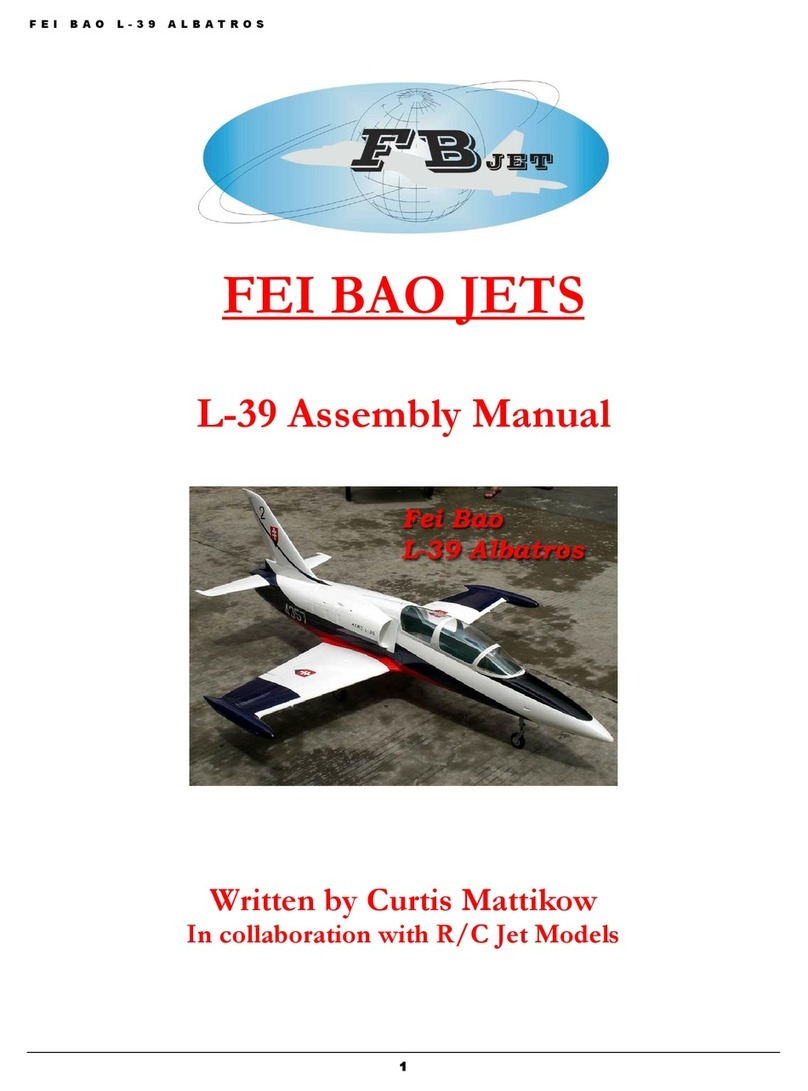
Fei Bao
Fei Bao L-39 User manual
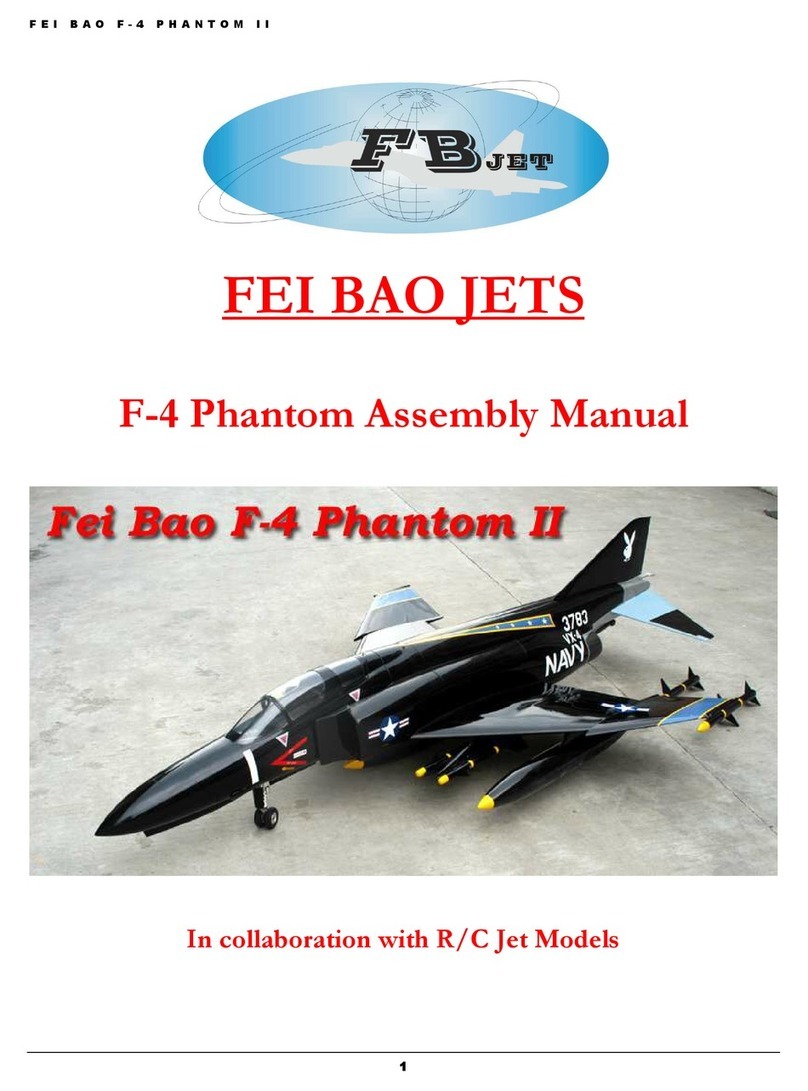
Fei Bao
Fei Bao F-4 Phantom II User manual

Fei Bao
Fei Bao EF2000 User manual
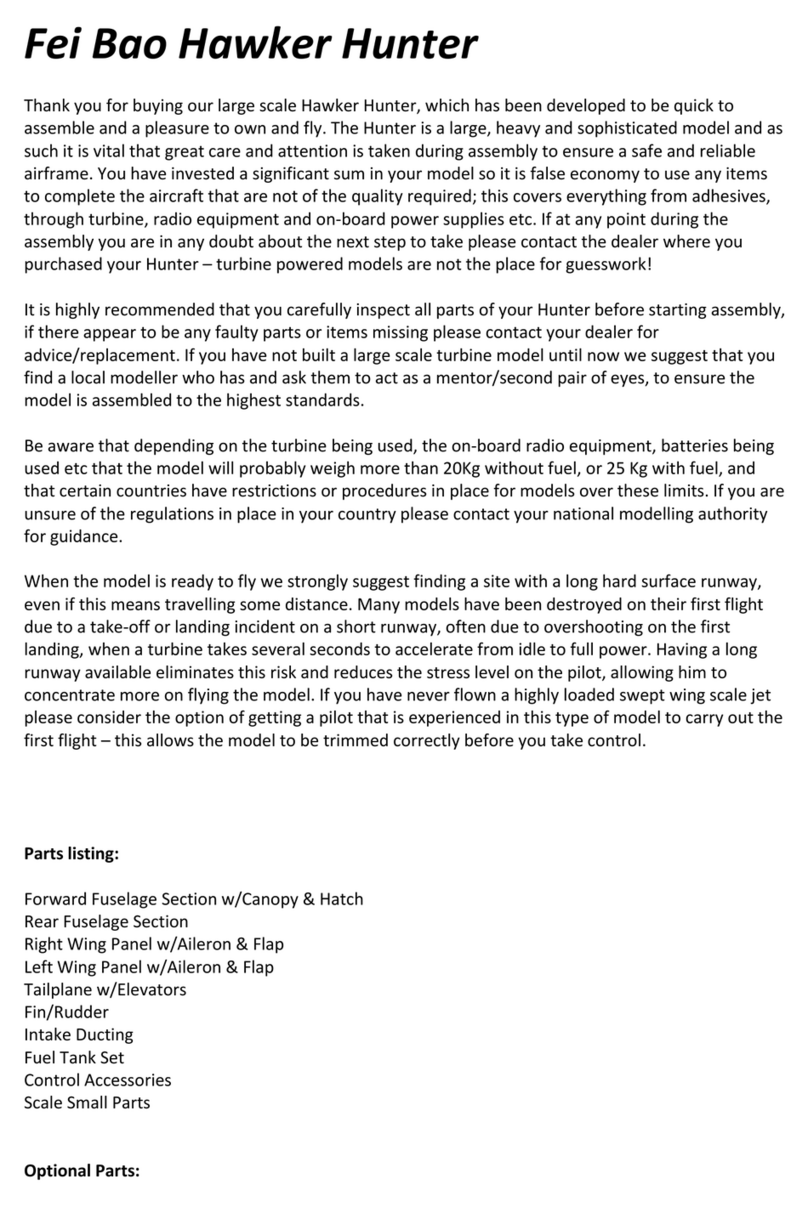
Fei Bao
Fei Bao hawker hunter User manual

Fei Bao
Fei Bao Mirage 2000 User manual
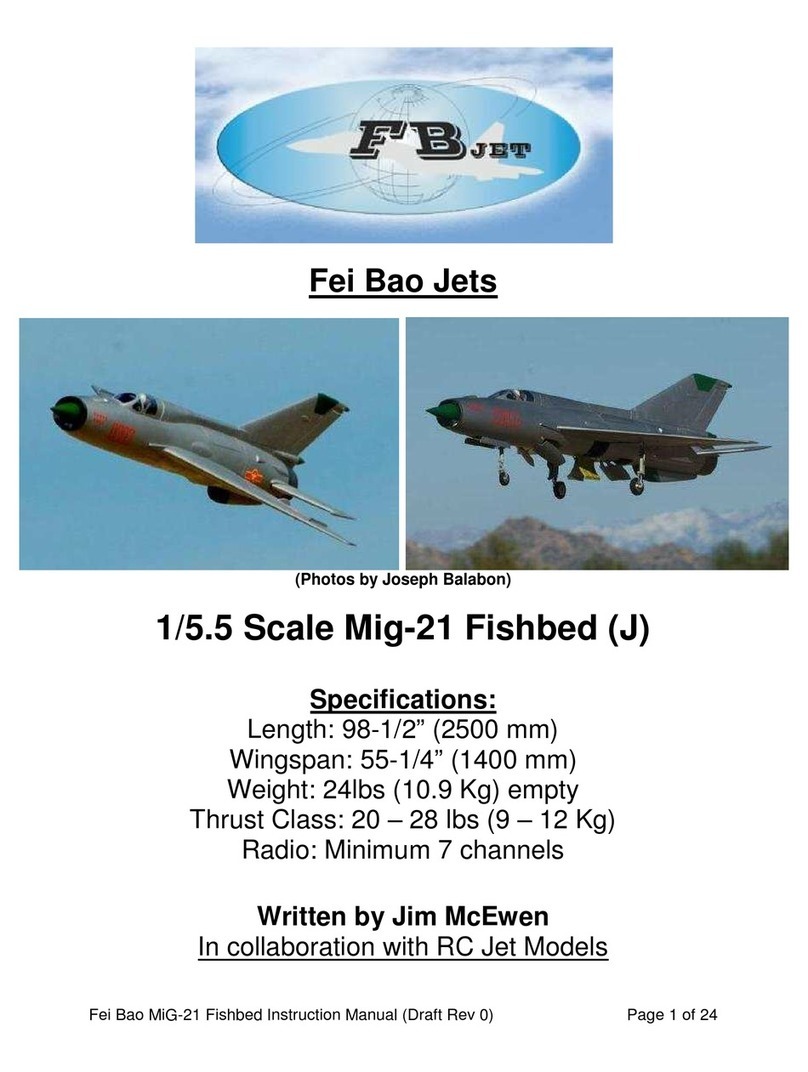
Fei Bao
Fei Bao MiG-21 Fishbed User manual
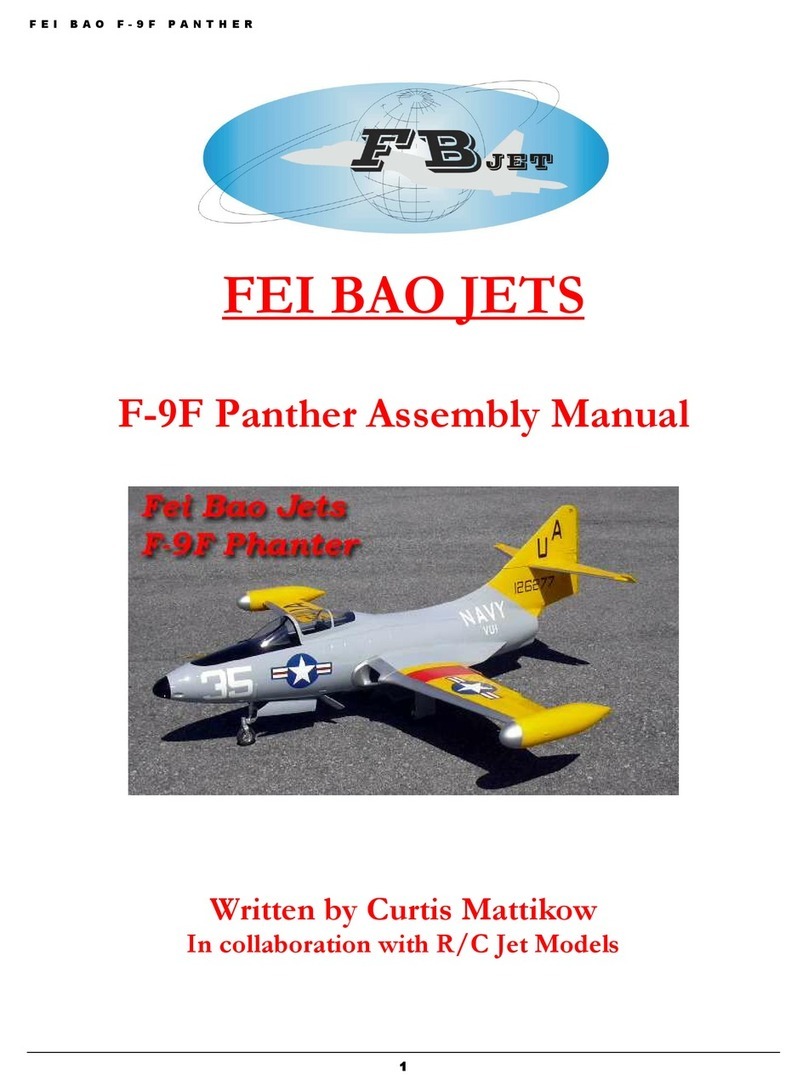
Fei Bao
Fei Bao F-9F Panther User manual
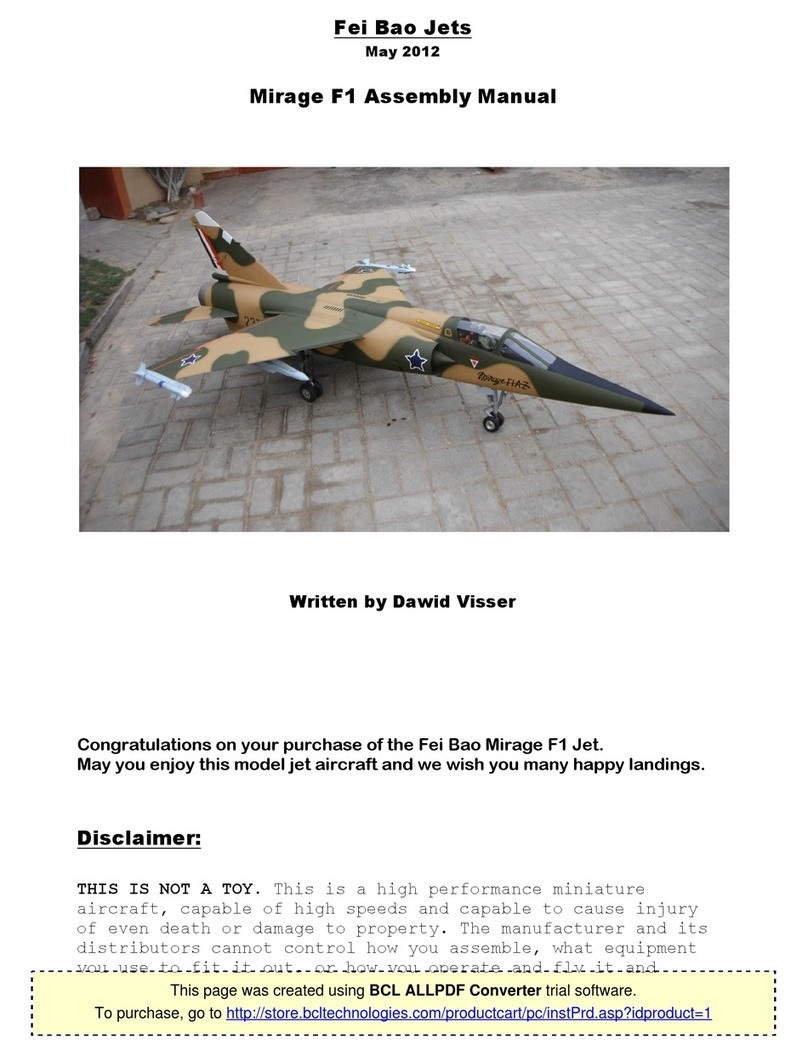
Fei Bao
Fei Bao Mirage F1 User manual
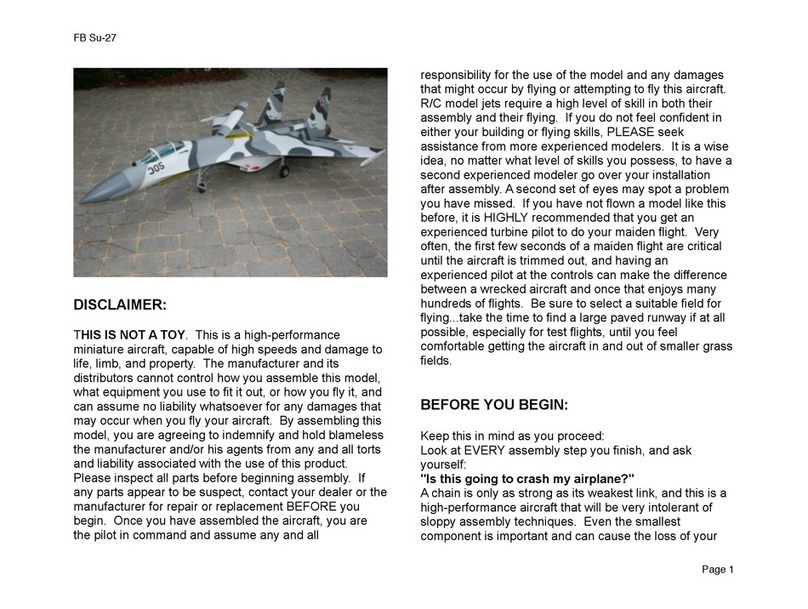
Fei Bao
Fei Bao SU-27 User manual
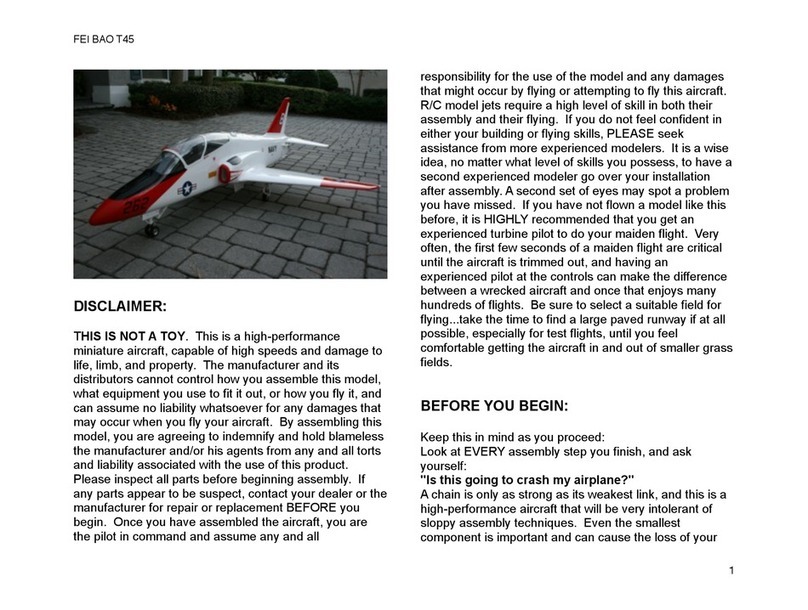
Fei Bao
Fei Bao T45 User manual
Popular Toy manuals by other brands

Fisher-Price
Fisher-Price R7879 instruction sheet

Rail King
Rail King Camelback 4-6-0 operating instructions
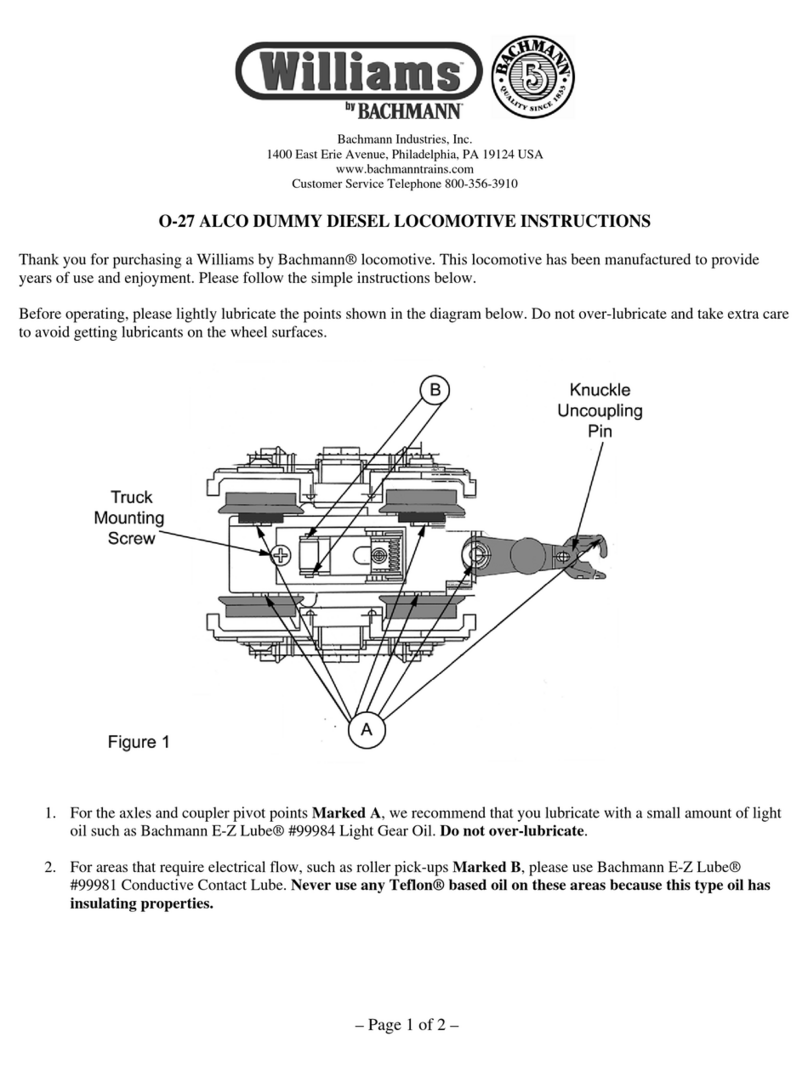
Bachmann
Bachmann Williams O-27 ALCO DUMMY instructions
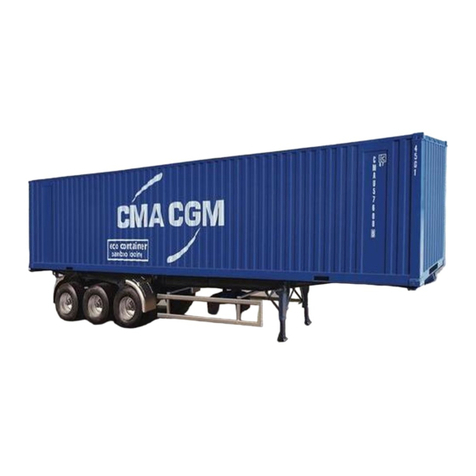
Italeri
Italeri 3951 manual
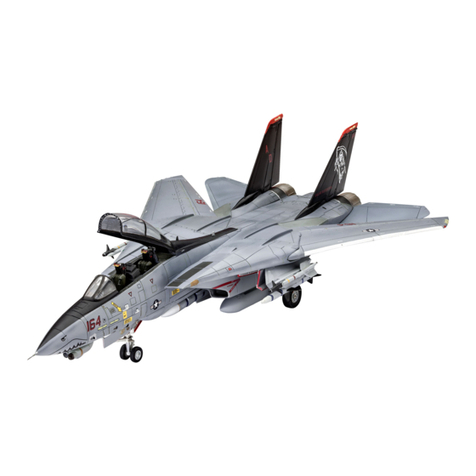
REVELL
REVELL F-14D Super Tomcat Assembly manual
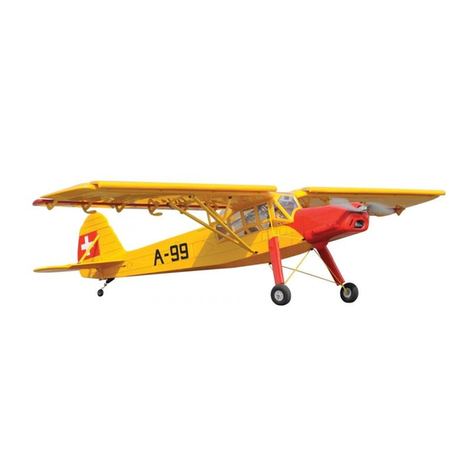
Black Horce Model
Black Horce Model FIESELER FI156C STORCH - EP Instruction manual book
